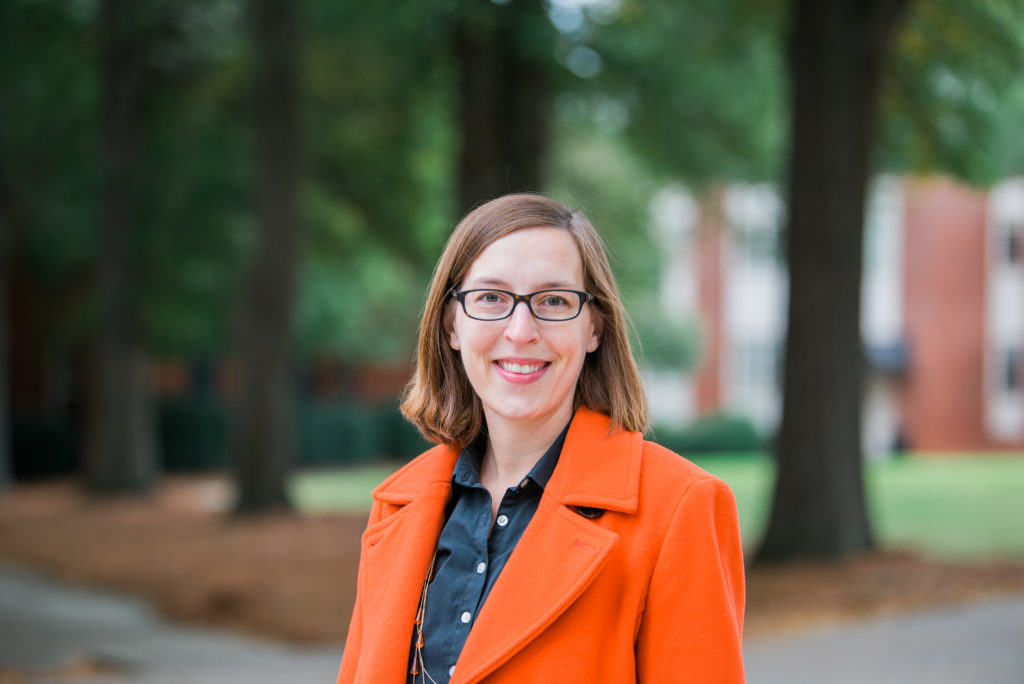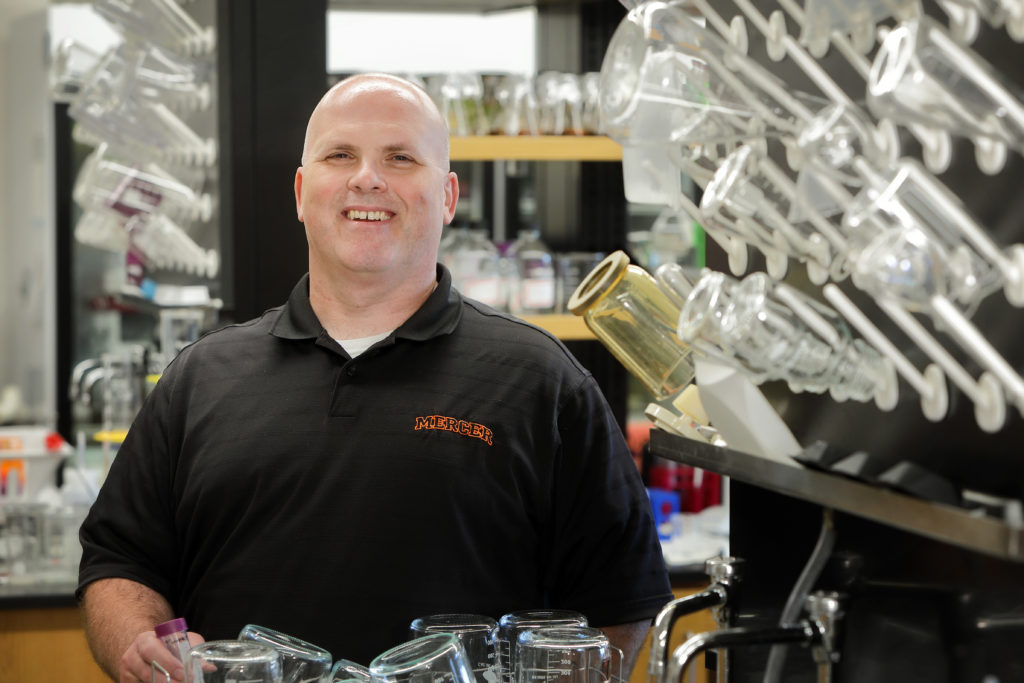Mercer University students don’t have to major in the sciences to discover how chemistry connects to the world around them. Chemistry 110 has become a popular summer course as it provides hands-on lab experiences and makes science more approachable for Bears in other academic fields.
Two versions of Chemistry 110 have been created by Mercer associate chemistry professors in recent years. This is the fifth summer that Dr. Kathy Kloepper has taught “The Chemistry of Bears” and the second summer for “The Chemistry of Food and Cooking,” which was designed and co-taught by Dr. Adam Kiefer and Dr. Garland Crawford in 2020 and is being taught by Dr. Crawford this summer.
Both courses run for five weeks — with one taught in the first summer session and the other in the second summer session — and are for students who need a scientific reasoning course to fulfill a general education requirement. Students come from all majors, but the majority are in the College of Business or College of Liberal Arts and Sciences.
About 50 students registered for each of the Chemistry 110 courses this summer. Because the classes are online and asynchronous, students work through the material and assignments at their own pace, although there’s still a lot of virtual interaction between the professor and students, Dr. Kloepper said.

The Chemistry of Bears
“There was a need for a general education chemistry course that would be offered in the summer,” said Dr. Kloepper, who is also the vice provost of engaged learning and director of Research that Reaches Out. “It was important for me to be able to contribute a course like this because it helps all of us gain a better understanding of how everything in the world connects to science, and in this case, chemistry.
“One of the reasons we have a science requirement is to build scientific literacy and to appreciate the connections around us. By having a chemistry class for non-majors, we have different ways we can go about looking at that.”
Dr. Kloepper said her mother, Marcia, an instructional designer for the University of New Mexico, had been urging her to teach this course for years. Dr. Kloepper finally got to work designing it in June 2016, and the two of them spent Christmas break that year testing potential lab experiments in Willet Science Center. It can be intimidating for students to conduct labs at home on their own, and Dr. Kloepper wanted to be sure she chose the right experiments.
She offered the course for the first time in May 2017, using the tagline, “If my mom can do it, you can do it.” It has remained one of her favorite courses to teach.
“The students in the class are going to learn concepts of chemistry, but rather than just watering them down, everything is built around the lab experience,” Dr. Kloepper said. “The learning outcomes are very much more about experimentation and analysis.”
The lessons and labs for each week go along with a Bear theme: “Find the Bear,” “Feed the Bear,” “Help the Bear,” “Entertain the Bear” and “Save the Bear.” Experiments include determining the blood type of simulated blood, making aspirin from the bark of a willow tree, and studying the effects that simulated acid rain has on lettuce seed germination. For the final project, students look at possible ways to remediate oil spills.
“I hope they feel like it’s been an authentic chemistry experience,” Dr. Kloepper said. “I hope they have fun. I hope they enjoy this class. I want them to be able to say, ‘I’m a chemist too.’”
Rising junior Isabelle Doane, a marketing major, said she took “The Chemistry of Bears” at the recommendation of several of her sorority sisters. Despite not being “a science person,” she said she found the course to be interesting and fun and appreciated that it was self-paced.
“My favorite part of the class was getting to do the experiments,” she said, noting that she especially enjoyed the acid rain lab and oil spill project. “They were both interesting and put more of a realistic perspective on how these things are affecting the environment. It was something you could apply to real life.”

The Chemistry of Food and Cooking
Dr. Crawford and Dr. Kiefer had been talking about creating this course for a while, and with many things on hold going into summer 2020 amid COVID-19, they decided it was the perfect time to do it. Dr. Crawford said he is excited about how “The Chemistry of Food and Cooking” has been developed and how well it was received by students last year. The class is being offered again this summer and starts June 28.
“It’s so fun. A lot of times teaching general chemistry, you try to fold in real-world examples. With food chemistry, you already have your real-world examples,” said Dr. Crawford, who is chair of the Chemistry Department. “You can throw out examples that you know students are familiar with. Our goal in this is to take something that students have had some exposure with and begin to show them chemistry connections.”
Students see that chemistry isn’t just happening in a building on campus; it’s going on all around them. The course puts their understanding of food in the context of chemistry, looking at chemical structures and what that means for how different foods behave in the kitchen.
Lesson topics include heat and energy; ways to cook; salt, solubility and pH; eggs and gelatins; fermentation; distillation; oils and fats; proteins; starches; and sugars. Students keep a food journal throughout the class and complete labs that are kitchen experiments.
Last year, students learned how microwaves work by heating a potato and measuring its temperature and weight; got a lesson in mass, volume and density as they made peanut butter fudge; and became familiar with acids and fermentation as they cooked sauerkraut.
“As a non-majors class, I think our approach is always a little different,” Dr. Crawford said. “It gives students an avenue to satisfy a graduation requirement, which is important, but it also gives them a way to do it that seems a little more approachable than a traditional general Chemistry 1 class. Hopefully, it will break down that barrier of intimidation of doing science. Students are always happy to say, ‘I’m not a science person.’ We want to lower that barrier and say, ‘You can do this.’”
It’s a chemistry class at heart, not a culinary class, so there’s room for students of all cooking skills. Dr. Crawford said his students have ranged from ones who have never boiled water to ones who cook frequently.
“I hope they leave with some appreciation of what’s going on around food,” he said. “I hope they have some understanding of not just the final product but how it got there and the chemical processes that went into it.”
Rising senior Amelia Rivers, a music and English double-major, was looking for a general education science course to take last summer, and Chemistry 110 was perfect for her. She said she couldn’t have asked for a better course.
“I’m very fascinated in how science works within the creative sphere. This ‘Chemistry of Food’ class was the perfect bridge. It showed the creative side of science that I’m obsessed with,” she said. “My favorite part was probably making sauerkraut because, A, it was delicious, and B, it was fascinating to see the differences between bases and acids and how it changed color.”








